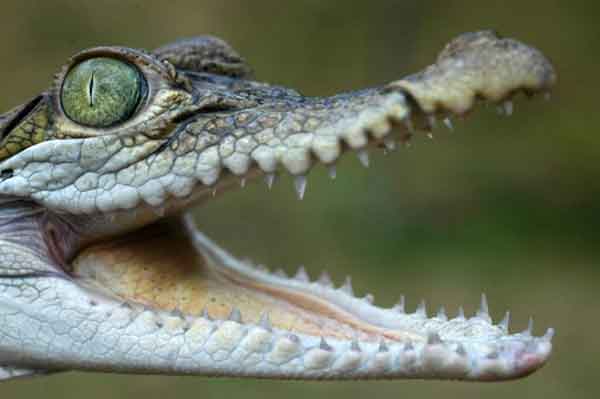Crocodylus mindorensis (*) Cladus: Eukaryota Name Crocodylus mindorensis Schmidt, 1935 Type locality: "the island of Mindoro, Philippine Islands" Holotype: FMNH 11135 Synonyms * Crocodylus mindorensis Schmidt, 1935
* Schmidt, K.P. 1935. "A new crocodile from the Philippine Islands." Field Museum of Natural History, Zoological Series, Chicago. 20 (8): 67-70
The Philippine crocodile (Crocodylus mindorensis) is a crocodile found in the Philippines.[1] It is also known as the Mindoro crocodile and the Philippine freshwater crocodile. In the Philippines, it is strictly prohibited to kill a crocodile, but its status is critically endangered from exploitation and unsustainable fishing methods,[2] such as dynamite fishing.[3] Conservation methods are being taken by the Dutch/Filipino Mabuwaya foundation,[4] the Crocodile Conservation Society and the Zoological Institute of HerpaWorld in Mindoro.
The Philippine crocodile is a relatively small freshwater crocodilian endemic to the Philippines. Growing no more than 3 meters, they have a relatively broad snout and thick bony plates on its back(heavy dorsal armor). Females are slightly smaller than males. Philippine crocodiles are golden-brown in color, which darkens as it matures. Distribution The Philippine crocodile is only found on the islands of the Philippines. This species of crocodile is one of the most severely threatened species around. There are probably less than 100 non-hatchling Philippine crocodiles surviving in the wild. The Philippine crocodile has been extirpated in Samar, Jolo, Negros Island, Masbate, and Busuanga. There are still surviving population in the Northern Sierra Madre National Park, San Mariano, Isabela, Dalupiri island in the Babuyan Islands, and Abra (province) in Luzon and Ligawasan Marsh in Mindanao.[5]. Ecology and life history The Philippine crocodile is a relatively small, freshwater crocodile. Until very recently it was considered a subspecies of the New Guinea crocodile (Crocodylus novaeguinae).[6] It was historically found in Luzon and parts of Visayas and Mindanao until the numbers were drastically cut by, mainly, habitat destruction. Conservation Although this species was once found over the whole of the Philippines, it is now critically endangered. In addition to this, very little is known about the natural history or ecology of the species, or its relationship with C. porosus, whose range it overlaps. More surveys are required to determine the present range. Initial population reduction was through commercial exploitation, although the current threat is mainly from removal of suitable habitat for agricultural purposes to satisfy a rapidly expanding human population. There is also very limited governmental support for any conservation measures, and the crocodiles are often killed by the local populace. This situation needs to be changed through awareness programs. Long-term captive breeding and release (through PWRCC, Silliman University and international breeding centres) is judged to be the best course to take at the present time, although it is imperative that a management program is drawn up for the remainder of the wild population (most of which resides in only one protected area). In 1992, there were estimated to be less than 1000 animals in the wild. In 1995, that estimate was revised to be no more than 100 non-hatchlings (note: hatchlings are rarely counted in surveys because their survivorship is so low). In 2007, a specialist group has been founded by several people within the Philippines, involved in crocodilian conservation. The Crocodile Conservation Society Philippines and the Zoological Institute of HerpaWorld working on Conservation Breeding and Release Programs. Crocodylus mindorensis was considered locally extinct in part of its former range in Northern Luzon until a live specimen was caught in San Mariano, Isabela in 1999. That individual, nicknamed 'Isabela' by its captors, was given to the care of the Crocodile Rehabilitation Observance and Conservation until it was released in August 2007. The specimen was 1.6 meters long at the time of its release.[7] This crocodile was featured in National Geographic's Dangerous Encounters hosted by crocodile specialist Dr. Brady Barr. In one of the episodes, Barr was seeking to be the first person to see all species of crocodile in the world, with the Philippine crocodile as the most difficult. Fortunately, he was able to see a Philippine crocodile only about two weeks old. [8] Bibliography * Philippine Crocodile: WhoZoo References 1. ^ Only in the Philippines - Endemic Animals in the Philippines txtmania.com.Accessed October 22, 2007. Source: Wikipedia, Wikispecies: All text is available under the terms of the GNU Free Documentation License |
|

